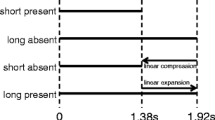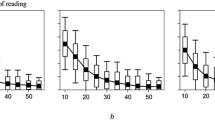Abstract
The purpose of the study was to investigate the influence of vocal frequency and vocal intensity upon the perception of speech rate at three levels of actual speech rate. A single sample of spontaneous speech was electronically varied to produce nine stimulus segments that factorially combined three levels each of vocal frequency and intensity. The nine stimuli were recorded such that preceding each was the original segment that served as the standard with which each of the nine stimuli was to be compared. The speech rate of the set of nine stimulus pairs was then electronically altered to obtain a slow set, a moderate set, and a fast set, although the duration of every segment in the three sets was 20 seconds. The sets were rated by different groups of judges in terms of four 7-point scales that measured perceived speech rate, pitch, loudness, and perceived duration. The results indicate that the perception of speech rate is positively related to vocal frequency and intensity at each of the three actual speech rates, and suggest that these relationships are a function of the repeated experience of almost always hearing such covariation in spontaneously occurring speech.
Similar content being viewed by others
Reference note
Apple, W.A schema-based model for integrating visible and vocal cues. Unpublished manuscript, Columbia University, 1981.
References
Allen, R. R., Anderson, S., & Hough, J.Speech in American society. Columbus, Ohio: Charles E. Merril, 1968.
Bendig, A. W. Reliability and the number of rating scale categories.Journal of Applied Psychology, 1954,38, 38–40.
Black, J. W. Relationships among fundamental frequency, vocal sound pressure, and rate of speaking.Language and Speech, 1961,4, 196–199.
Brown, B. L., Strong, W. J., & Rencher, A. C. Manipulations of vocal qualities by speech synthesis: A new way to study person perception.Proceedings of the 80th Annual Convention of the American Psychological Association, 1972,7, 197–198.
Brown, B. L., Strong, W., & Rencher, A. C. Perceptions of personality from speech: Effects of monipulations of acoustical parameters.Journal of the Acoustical Society of America, 1973,54, 29–35.
Brown, B. L., Strong, W. J., & Rencher, A. C. Fifty-four voices from two: The effects of simultaneous manipulations of rate, mean fundamental frequency, and variance of fundamental frequency on ratings of personality from speech.Journal of the Acoustical Society of America, 1974,55, 313–318.
Elmore, P. B., & Beggs, D. L. Salience of concepts and commitment to extreme judgments in the response patterns of teachers.Education, 1975,95, 325–330.
Feldstein, S., & Bond, R. N. Perception of speech rate as a function of vocal intensity and frequency.Language and Speech, 1981,24, 385–392.
Follman, J., Merica, J., & Silverman, S. Negative numbers and order of numbers in student ratings.Perceptual and Motor Skills, 1974,38, 10.
Goldman-Eisler, F. The determinants of the rate of speech output and their mutual relations.Journal of Psychosomatic Research, 1961,1, 147.
Grosjean, F., & Lane, H. Effects of two temporal variables on the listener's perception of reading rate.Journal of Experimental Psychology, 1974,102, 893–896.
Komorita, S. S., & Graham, W. K. Number of scales points and the reliability of scales.Education and Psychological Measurement, 1965,25, 987–995.
Mehrabian, A. Nonverbal betrayal of feelings.Journal of Experimental Research in Personality, 1971,5, 64–73.
Miller, N., Maruyama, G., Beaber, R. J., & Valone, K. Speed of speech and persuasion.Journal of Personality and Social Psychology, 1976,34, 615–624.
Murray, H. A.Explorations in personality. New York: Oxford, 1938.
Rummelhart, D. E., & Ortony, A. The representation of knowledge in memory. In R. C. Anderson, R. J. Spiro, & W. E. Montague (Eds.),Schooling and the acquisition of knowledge. Hillsdale, New Jersey: Erlbaum, 1977.
Scherer, K. R. Acoustic concomitants of emotional dimensions: Judging affects from synthesized tone sequences. In S. Weitz (Ed.),Nonverbal communication. New York: Oxford, 1974. Pp. 105–111.
Scherer, K. R. Inference rules in personality attribution from voice quality: The loud voice of extraversion.European Journal of Social Psychology, 1978,8, 467–487.
Scherwitz, L., Berton, B. S., & Leventhal, H. Type A assessment and interaction in the behavior pattern interview.Psychosomatic Medicine, 1977,39, 229–240.
Shucker, B., & Jacobs, D. R. Assessment of behavioral risk for coronary disease by voice characteristics.Psychosomatic Medicine, 1977,39, 219–228.
Smith, B. L., Brown, B. L., Strong, W. J., & Rencher, A. C. Effects of speech rate on personality perception.Language and Speech, 1975,18, 145–152.
Stevens, S. S.Psychophysics: Introduction to its perceptual, neural, and social prospects. New York: Wiley, 1975.
Stevens, S. S., & Volkmann, J. The relation of pitch to frequency: A revised scale.American Journal of Psychology, 1940,53, 329–353.
Susskind, E. C., & Howland, E. W. Measuring effect magnitude in repeated measures ANOVA designs: Implications for gerontological research.Journal of Gerontology, 1980,35, 867–876.
Symonds, P. M. On the loss of reliability in ratings due to coarseness of the scale.Journal of Experimental Psychology, 1924,7, 456–461.
Taylor, S. E., & Crocker, J. Schematic bases of social information processing. In E. T. Higgins, P. Herman, & M. P. Zanna (Eds.),The Ontario Symposium on personality and social psychology (Vol. 1). Hillsdale, New Jersey: Erlbaum, 1979.
Author information
Authors and Affiliations
Additional information
The authors are indebted to the Language Laboratory of the University of Maryland Baltimore County and are grateful for the generous amount of computer time provided by the Computer Centers of the Baltimore County and College Park campuses of the university. They are also indebted to Mr. George J. Johnson, Jr., for the design and construction of the instrument used in the study, to Drs. Edwin Susskind and Jahathan Finkelstein for their active concern about the meaning of the results, and to Dr. Klaus Scherer for his very helpful critique.
Rights and permissions
About this article
Cite this article
Bond, R.N., Feldstein, S. Acoustical correlates of the perception of speech rate: An experimental investigation. J Psycholinguist Res 11, 539–557 (1982). https://doi.org/10.1007/BF01067611
Accepted:
Issue Date:
DOI: https://doi.org/10.1007/BF01067611




